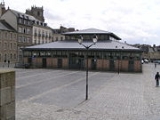
Jean-Baptiste Martenot
Encyclopedia
Jean-Baptiste Martenot was a French architect, born in Bourgogne
, in the city of Rennes
. The Halles Martenot and the Préfecture Martenot are names in his honour. He is a former student of the école des Beaux-Arts
.
Born in Saint-Seine-l'Abbaye
(Côte-d’Or), 26 July 1828 - Died 30 March 1906 in Rennes.
From humble beginnings, he obtained a departmental pension to study at the École nationale des Beaux-Arts in Paris, which he attended until 1850. He won the prix Muller Sœhnée.
At 26, Martenot was named inspector of the Palais du Louvre.
In 1858, the mayor of Rennes Léon des Ormeaux appointed him to the post of chief architect of the city of Rennes, a post he held until 1895.

Bourgogne
Burgundy is one of the 27 regions of France.The name comes from the Burgundians, an ancient Germanic people who settled in the area in early Middle-age. The region of Burgundy is both larger than the old Duchy of Burgundy and smaller than the area ruled by the Dukes of Burgundy, from the modern...
, in the city of Rennes
Rennes
Rennes is a city in the east of Brittany in northwestern France. Rennes is the capital of the region of Brittany, as well as the Ille-et-Vilaine department.-History:...
. The Halles Martenot and the Préfecture Martenot are names in his honour. He is a former student of the école des Beaux-Arts
École des Beaux-Arts
École des Beaux-Arts refers to a number of influential art schools in France. The most famous is the École nationale supérieure des Beaux-Arts, now located on the left bank in Paris, across the Seine from the Louvre, in the 6th arrondissement. The school has a history spanning more than 350 years,...
.
Born in Saint-Seine-l'Abbaye
Saint-Seine-l'Abbaye
Saint-Seine-l'Abbaye is a commune in the Côte-d'Or department in eastern France.It is also a place steeped in history with its archaeological sites, the goddess Sequana; nymph Sources close to the Seine and Alesia, the remnants of its ancient abbey, the abbey church, a jewel of Gothic art...
(Côte-d’Or), 26 July 1828 - Died 30 March 1906 in Rennes.
From humble beginnings, he obtained a departmental pension to study at the École nationale des Beaux-Arts in Paris, which he attended until 1850. He won the prix Muller Sœhnée.
At 26, Martenot was named inspector of the Palais du Louvre.
In 1858, the mayor of Rennes Léon des Ormeaux appointed him to the post of chief architect of the city of Rennes, a post he held until 1895.
His works
- His work in Rennes is important. He built a number of communal buildings, schools, markets, the belfry of the town hall, the chamber of commers, the bank, the buildings of the park, parts of the school of medicine and faculty of sciences, and the church Saint-Aubin-en-Notre-Dame-de-Bonne-Nouvelle, in Place Sainte-Anne (1884-1904).
- He is the one who addressed the general plan for the viability of the municipal canalisation of drinking water.

- The two Lices pavilions were built in 1868 and 1871 in the same style as the old Les HallesLes HallesLes Halles is an area of Paris, France, located in the 1er arrondissement, just south of the fashionable rue Montorgueil. It is named for the large central wholesale marketplace, which was demolished in 1971, to be replaced with an underground modern shopping precinct, the Forum des Halles...
by Victor BaltardVictor BaltardVictor Baltard , French architect, who was born in Paris, son of architect Louis Baltard.Until 1833, Baltard studied at the École des Beaux-Arts, where he garnered the Prix de Rome for designing a military school in 1833...
. The halles de Rennes were rare metal buildings, in a city principally built of wood and stone. - The collège-lycée Émile-Zola was built in a style combining graniteGraniteGranite is a common and widely occurring type of intrusive, felsic, igneous rock. Granite usually has a medium- to coarse-grained texture. Occasionally some individual crystals are larger than the groundmass, in which case the texture is known as porphyritic. A granitic rock with a porphyritic...
, tufaTufaTufa is a variety of limestone, formed by the precipitation of carbonate minerals from ambient temperature water bodies. Geothermally heated hot-springs sometimes produce similar carbonate deposits known as travertine...
and brickBrickA brick is a block of ceramic material used in masonry construction, usually laid using various kinds of mortar. It has been regarded as one of the longest lasting and strongest building materials used throughout history.-History:...
. - He also had a number of private clients, in particular, a number of hotels (hôtel Claudet, hôtel Léofanti, hôtel des Nétumières, hôtel de Léon…) and châteaux (château à Plénée-JugonPlénée-JugonPlénée-Jugon is a commune in the Côtes-d'Armor department in Bretagne in northwestern France.-Population:Inhabitants of Plénée-Jugon are called plénéens.-External links:*...
(attributed, around 1860), château du Breil à LourmaisLourmaisLourmais is a commune in the Ille-et-Vilaine department in Bretagne in north-western France.-Demographics:Inhabitants of Lourmais are called Lourmaisiens.-References:* ;* -External links:*...
(1862, château de Bonnefontaine à AntrainAntrainAntrain is a commune in the Ille-et-Vilaine department of Brittany in north-western France.-Demographics:Inhabitants of Antrain are called in French Antrenais....
, restoration of château de Craffault (1899-1902) and gallery, North pavilion (1902) à PlédranPlédranPlédran is a commune in the Côtes-d'Armor department of Brittany in northwestern France.-Population:Inhabitants of Plédran are called plédranais.-External links:*...
, Côtes-d’Armor). He also built industrial establishments, such as the Imprimerie Oberthür (1870).

